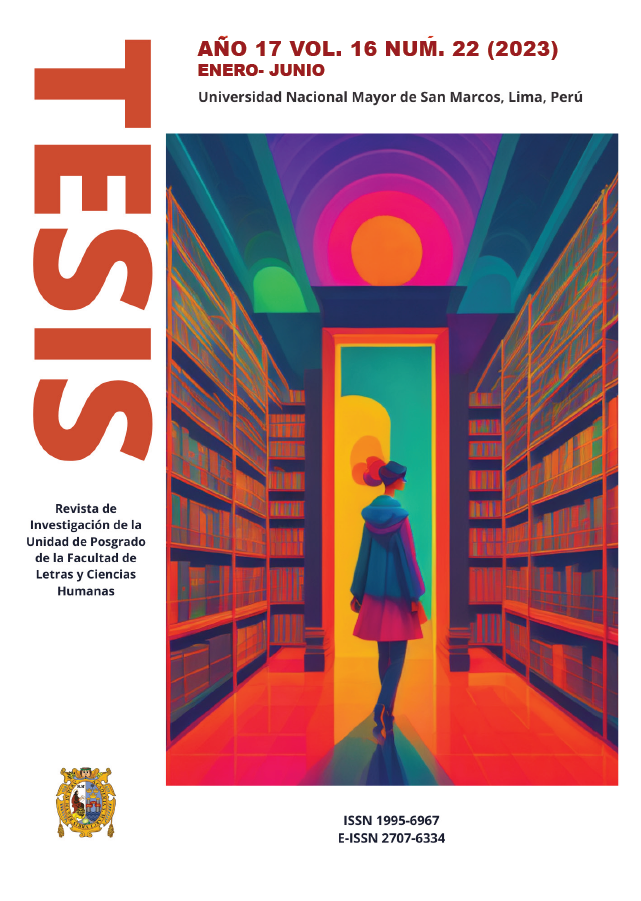Novel fiction and cinematographic fiction in Garabombo, el invisible (1972) by Manuel Scorza
DOI:
https://doi.org/10.15381/tesis.v16i22.21925Keywords:
novel, movies, memory, myth, heroAbstract
The article proposes to approach the second novel of The silent war cycle by Manuel Scorza, formulating the hypothesis of a fictional fiction based on real events, but also thought as a cinematographic fiction. The relationship between fictional fiction and cinematographic fiction is notable in the writing of Garabombo, el invisible and opens up new narrative perspectives for the other novels of an epic cycle whose objective is the future memorization of the heroes in the collective memory.
References
Atarama-Rojas, T. y Vílchez Chiroque, F. (2018). El uso del travelling como marca del estilo de Wes Anderson: análisis de Academia Rushmore (1998), Los Tenenbaums: una familia de genios (2001) y El Gran Hotel Budapest (2014). Fotocinema, Revista de cine y fotografía, 17, 321-342. https://dialnet.unirioja.es/descarga/articulo/6538532.pdf
Berrío Meneses, C. M. (2016). Particularidades del héroe mítico y el cinematográfico. Revista Luciérnaga, 8(16), 59-68.
Boussafi N. (2021). El montaje cinematográfico como técnica narrativa en La muerte de Artemio Cruz de Carlos Fuentes. [Tesis doctoral en Literatura Hispanoamericana, Universidad de Argel II Abou El Kacem Saâdallah].
Cardona Zuluaga, P. (2012). Del héroe mítico, al mediático. Las categorías heroicas: héroe, tiempo y acción. Revista Universidad EAFIT, 42(144). https://publicaciones.eafit.edu.co/index.php/revista-universidad-eafit/article/view/786
Duffey, J. P. (1996). De la pantalla al texto. La influencia del cine en la narrativa mexicana del siglo veinte. Universidad Nacional Autónoma de México.
Escribano, P. (25 de mayo de 2019). El guión inédito de Garabombo, el invisible. La República.
Lévi-Strauss, C. (1979). Antropología estructural. Mito, sociedad, humanidades. Siglo xxi.
Mercado, G. (2011). La visión del cineasta. Anaya Multimedia.
Mosqueda Pulgarín, M. (2008). Imagenoma. La influencia del cine en la literatura. Universidad Autónoma Metropolitana.
Ribes, J. P. (2005). El héroe clásico en el relato cinematográfico. Area Abierta, 13, 5-8. https://revistas.ucm.es/index.php/ARAB/article/view/ARAB0606130005A
Scorza, M. (1979). La tumba del relámpago. Siglo xxi.
Scorza, M. (1981). Libérez l’imaginaire. Préface. En G. Hennebelle y Alfonso Gumucio Dagron (eds.), Les Cinémas de l’Amérique latine. Lherminier.
Scorza, M. (1984a). Garabombo, el invisible. Plaza y Janés.
Scorza, M. (1984b). El jinete insomne. Plaza y Janés.
Scorza, M. (2019). Redoble por Rancas. Cátedra.
Yanes Gómez, G. (1996). Juan Rulfo y el cine. Universidad de Guadalajara.
Downloads
Published
Issue
Section
License
Copyright (c) 2023 Jean-Marie Lassus

This work is licensed under a Creative Commons Attribution 4.0 International License.
THE AUTHORS RETAIN THEIR RIGHTS:
(a) The authors retain their trademark and patent rights, and also on any process or procedure described in the article.
(b) The authors retain the right to share, copy, distribute, execute and publicly communicate the article published in Tesis (Lima) (in example, depositing the article in an institutional repository or publish it in a book), with recognition of its initial publication in the Tesis (Lima).
(c) The authors retain the right to make a later publication of their work, to use the article or any part of it (for example: a compilation of their works, notes for conferences, thesis, or for a book), provided that they indicate the source of publication (authors of the work, magazine, volume, number and date).














